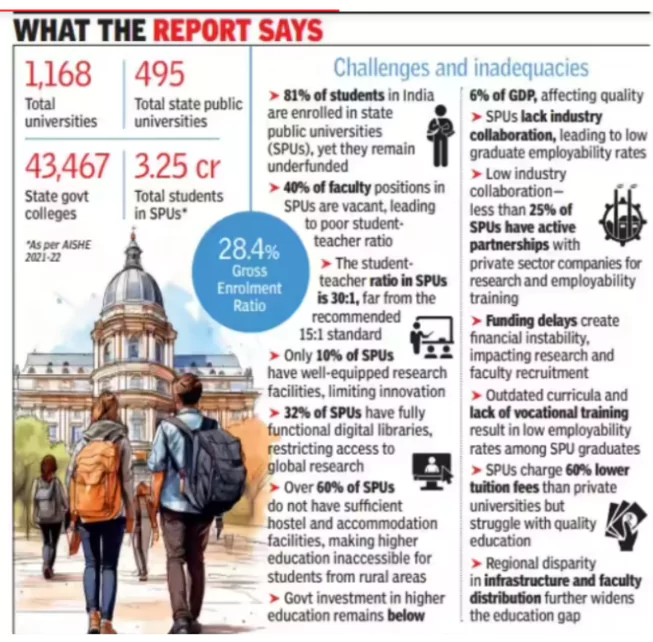The latest QS World University Rankings 2026 mark a turning point in India’s higher education trajectory. With 54 institutions featured, the country has registered its best-ever performance in global rankings.
- India now ranks as the 4th most represented country, following the US, UK, and China. This signals not just an increase in quantity but also a qualitative shift in global academic perception of Indian institutions.
India’s Performance in QS Rankings 2026
- 8 new Indian universities entered the rankings in 2026 — the highest addition by any country.Of these, 7 are private universities, highlighting the growing role of the private sector.
| Institution |
Global Rank |
Indian Rank |
| IIT Delhi |
123 |
1 |
| IIT Bombay |
129 |
2 |
| IIT Madras |
180 |
3 |
Reasons for Improved Rankings
- Improved Employer Reputation
- IIT Delhi ranks 50th globally in employer reputation.
- The global demand for Indian STEM graduates has boosted institutional credibility.
- Higher Research Output
- IIT Delhi now ranks 86th in citations per faculty.
- Enhanced research productivity and greater international academic visibility have contributed significantly.
- International Collaborations
- MoUs and research partnerships with global universities have strengthened India’s academic ecosystem.
- Sustainability Metrics
- QS has introduced Sustainability as a ranking factor.
- IIT Delhi ranks 172nd globally, reflecting India’s growing focus on green campuses and SDG compliance.
- Institutional Reforms
- Government initiatives like Institutions of Eminence (IoE) have granted select universities greater autonomy, promoting excellence.
Challenges in the Higher Education Sector
Despite global recognition, critical issues persist:
1. Quality Concerns in Private HEIs
- While private university enrolment grew 497% between 2011-12 and 2021-22, many operate in regulatory grey areas, compromising on academic rigor, transparency, and research standards.
2. Infrastructure and Faculty Shortages
- State and central public universities report chronic faculty vacancies, outdated infrastructure, and underfunding.
 A NITI Aayog report highlights the challenges facing state universities in particular (Refer Image).
A NITI Aayog report highlights the challenges facing state universities in particular (Refer Image).
- > 40% of faculty positions in SPUs are vacant, leading to poor student-teacher ratio.
3. Low Government Spending
- Government expenditure on education remains around 3% of GDP, inadequate for meeting rising demand and global competition (NEP recommended 6% of GDP).
4. Regulatory Inconsistencies
- Delayed implementation of key reforms under National Education Policy (NEP) 2020 hampers institutional growth.
- Eg. The Ministry of Human Resource Development failed to pass the Higher Education Commission of India (HECI) Bill, 2018, which aims to repeal the seven-decade-old University Grants Commission (UGC) Act, 1956.
Way Forward
- Fast-track NEP Implementation
- Clear timelines and frameworks are needed for reforms such as Multidisciplinary Education and Research Universities (MERUs) and academic credit systems.
- Strengthen Public Institutions
- Effective use of the increased education budget (₹50,077.95 crore for 2025-26) to hire qualified faculty, upgrade labs, libraries, and digital infrastructure.
- Enhance Regulatory Oversight of Private HEIs
- Ensure accreditation, quality checks, and periodic reviews to maintain academic integrity.
- Foster Industry-Academia Linkages
- Promote research parks, innovation hubs, and internships to align curriculum with market needs.
- Boost Internationalization
- Encourage exchange programs, joint degrees, and faculty collaboration with top foreign universities.
- NITI Aayog Recommendations: (refer image)

Conclusion
India’s performance in the QS World University Rankings 2026 is a milestone, reflecting years of incremental reform, institutional innovation, and global engagement.
- However, to transform this academic visibility into sustainable quality and equity in education, policy implementation, robust public funding, and regulatory overhaul must accompany these achievements.
- Only then can India truly become a global knowledge hub and achieve its demographic dividend.
![]() 24 Jun 2025
24 Jun 2025

 A NITI Aayog report highlights the challenges facing state universities in particular (Refer Image).
A NITI Aayog report highlights the challenges facing state universities in particular (Refer Image).

